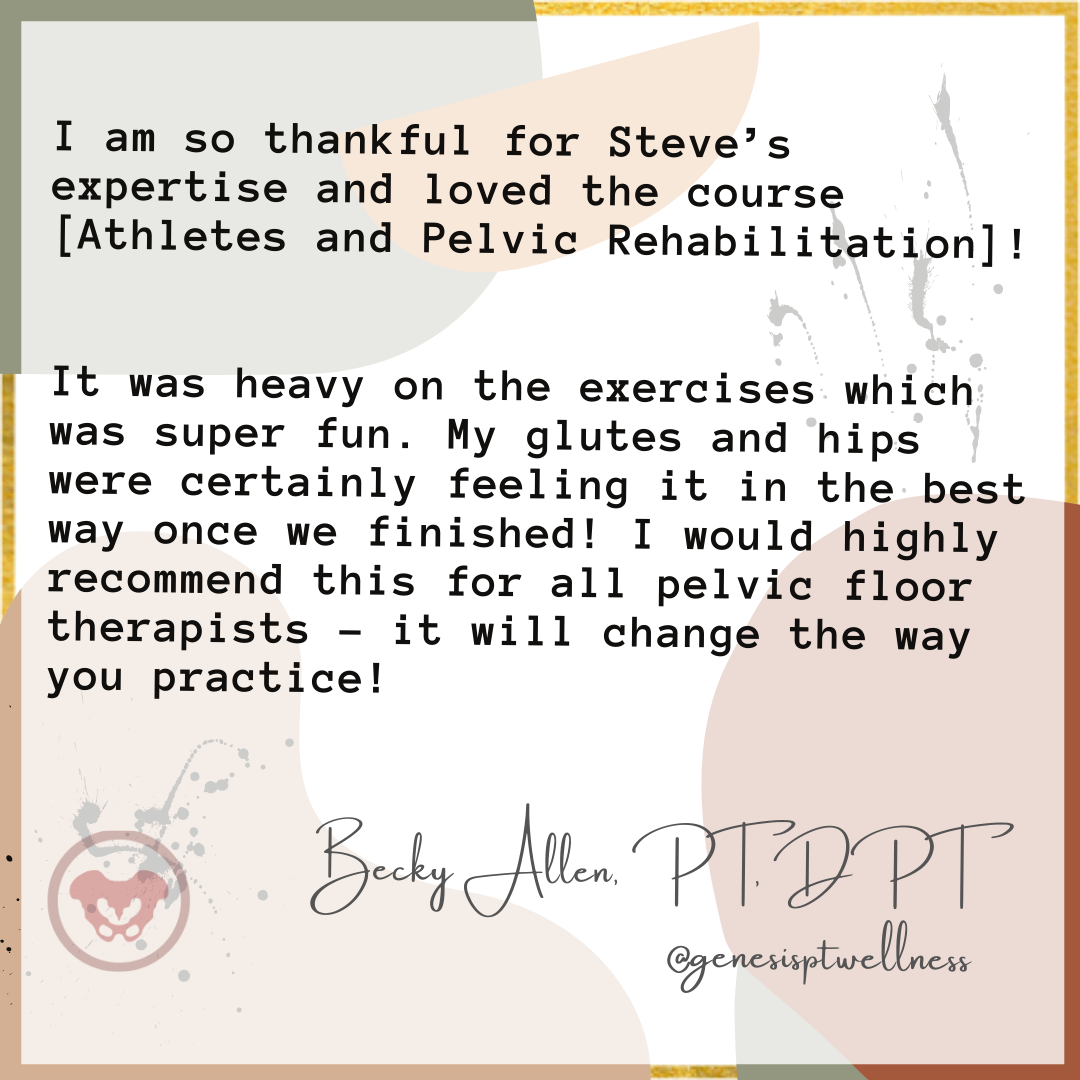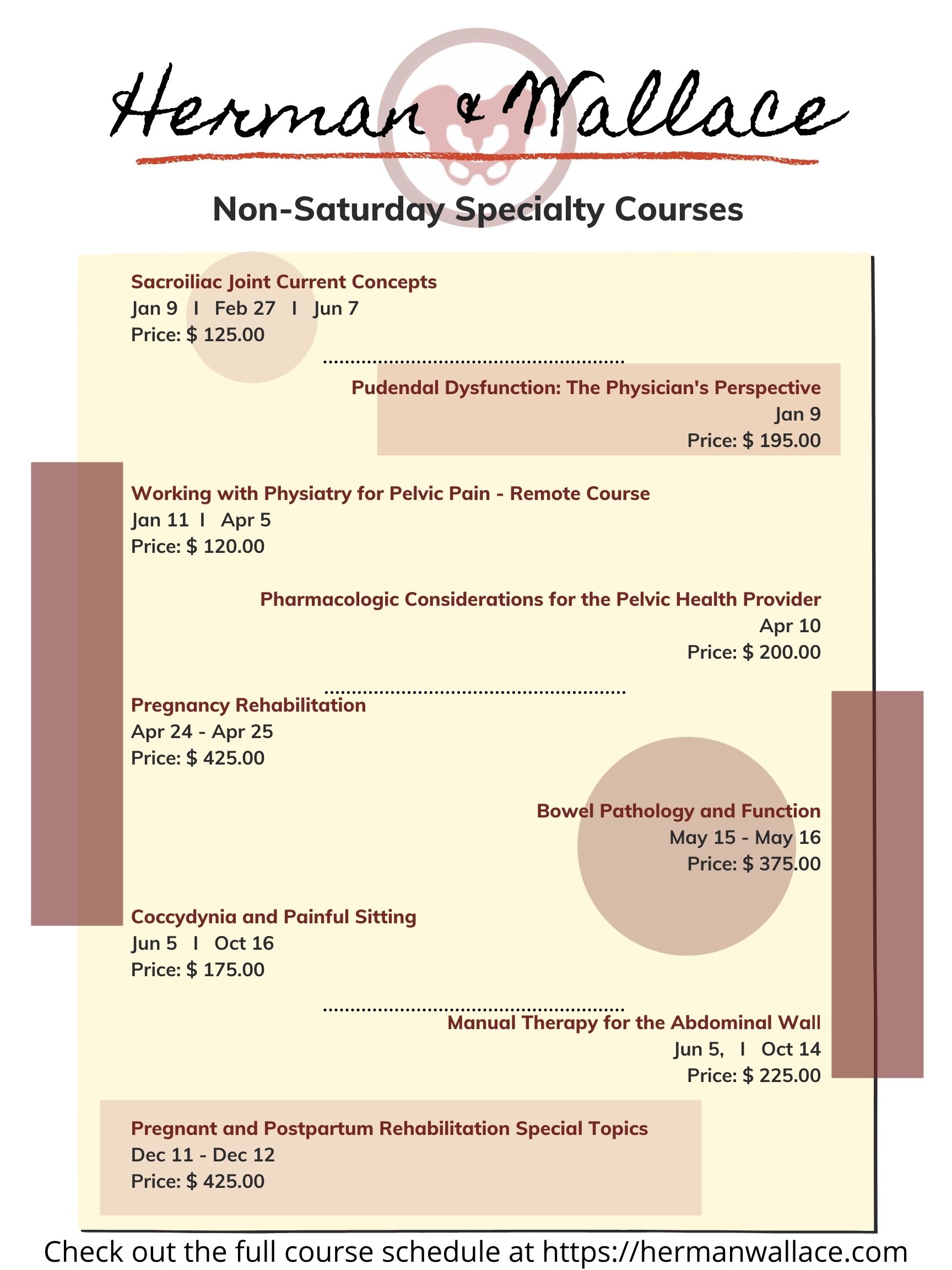
The hip flexor muscles include the Iliopsoas group (Psoas Major, Psoas Minor, and Iliacus), Rectus Femoris, Pectineus, Gracillis, Tensor Fascia Latae, and Sartorius. When the hip flexors are tight it can cause tension on the pelvic floor. This can pull on the lower back and pelvis as well as change the orientation of the hip socket, lead to knee pain, foot pain, bladder leakage, prolapse, and so much more. The ramifications of iliacus and iliopsoas dysfunctions are discussed in a contemporary and evidence-based model with Steve Dischiavi in the Athletes & Pelvic Rehabilitation remote course.
A common issue with the iliacus and hip flexors is that they can shorten over time due to a lack of stretching or a sedentary lifestyle. When this happens, the muscle adapts by becoming short, dense, and inflexible and can have trouble returning to its previous resting length. A muscle that resides in this chronic contraction can become ischemic, develop trigger points, and distort movement in the body.
If you are treating patients with pain in their lower abdomen, sacroiliac joint, or that wraps around the lower back and buttocks, it could be because the hip flexors are tight. Traditional testing performed by medical practitioners tends to come back negative as many tests do not evaluate soft tissue issues. The best way to diagnose these concerns is through assessment with skilled palpation and structural evaluation.

This is a common question that faculty member, Mercedes Eustergerling, is asked. To paraphrase this question – why does H&W (a pelvic rehabilitation institute) offer a breastfeeding course – Breastfeeding Conditions? Well, if you consider that new parents who are breastfeeding have just experienced a birthing event then the answer is – it has plenty to do with pelvic rehabilitation.
Most pelvic therapists have exposure to patients who have given birth and are experiencing a range of postpartum pelvic issues including painful intercourse, prolapse, and incontinence. Have you considered how breastfeeding affects these issues? After giving birth the body’s levels of estrogen drop and the levels of prolactin rise. Prolactin is the hormone responsible for stimulating milk production and will remain elevated during breastfeeding. Thus, estrogen levels remain low during this time and can result in vaginal dryness, delayed menses, low libido, and painful sex.
Women or any person who has experienced childbirth, with pelvic organ prolapse (POP) are often told that the condition will improve after breastfeeding. While many do see improvement after weaning their child there is no correlation between breastfeeding slowing the healing of pelvic floor muscles or worsening POP long-term (1). POP has been linked with sleep quality (2). Which anyone with a newborn can tell you is in short supply. Not surprisingly, sleep is important for your body to recover from birthing, managing postpartum mood disorders, and of course, staying awake to take care of your baby. For breastfeeding parents, sleep deprivation is a way of life as they are waking up every 2-3 hours to feed their baby and establish a strong milk supply. It may be beneficial at this point for the new parent to work with a lactation consultant. These professionals can guide new parents through latching, feeding, milk supply issues, breast pump use, and can help reduce stress and promote optimal rest and recovery postpartum.
Mia Fine, MS, LMFT, CST, CIIP is the creator of the remote course, Sexual Interviewing for Pelvic Health Therapists. This course is for pelvic rehab therapists who want to learn tools and strategies from a sex therapist’s toolkit who works with patients experiencing pelvic pain, pelvic floor hypertonicity, and other pelvic floor concerns. Mia (they/she) is a student of Queer Theory, Intersectionality, and Social Justice and offers holistic, anti-oppressive, and trauma-informed therapy in the Seattle area.
As a Licensed Marriage and Family Therapist, Certified Medical Family Therapist and trained AASECT Certified Sex Therapist, Mia has clocked hundreds of hours in direct client contact, supervision, and consultation. She has also attended numerous sex therapy trainings, continuing education opportunities, and trains incoming sex therapists on current modalities and working with vulnerable client populations.
Sexuality is core to most human beings’ identity and daily experiences. Human beings are hard-wired for connection, intimacy, and pleasure. When there are concerns relating to our sexual identity, sexual health, and capacity to access our full potential, it affects our quality of life and holistic well-being. Practitioners who work with folks on issues of sexual health and decreasing sexual dysfunction are in the position to encourage awareness and healing. Mia shares, “Imagining a world where human beings don’t walk around holding shame or traumatic pain is imagining a world of health and happiness.”
How do you explain pain to a patient? How do you reeducate the nervous system to be less sensitive? These are the questions that Tara Sullivan, PT, DPT, PRPC, WCS, IF, and Alyson N Lowrey, PT, DPT, OCS address in their new course Pain Science for the Chronic Pelvic Pain Population. The chronic pain population is often dismissed or misled that they have something drastically wrong with them, or worse, nothing wrong with them at all. Alyson and Tara share that “this population often has the most functional deficits and the worst clinical outcomes. We want to change that.”
Tara has specialized exclusively in pelvic floor dysfunction treating bowel, bladder, sexual dysfunctions, and pelvic pain since 2012. Alyson became involved with pelvic rehabilitation through working in a clinic with Tara Sullivan. She is a board-certified orthopedic specialist and primarily works with the ortho patient population. When Tara came into the clinic she brought along the pelvic floor population and they joined forces. Alyson, with her ortho perspective, is better able to recognize that in some of her orthopedic patients, a lot of their pain was coming from the pelvic floor. The pelvic pain patient population crosses over from physical therapy to the orthopedic and occupational therapy worlds. By treating their patients wholistically Tara and Alyson have been able to make a huge difference to both of their practices.
By focusing specifically on the topic of pain science in their new course, Tara and Alyson delve into the true physiology of pain including the topics of central and peripheral sensitization. Pelvic specialists that can benefit from this course are those whose patients have chronic pelvic pain including endometriosis, interstitial cystitis, irritable bowel syndrome, vaginismus, vestibulodynia, primary dysmenorrhea, and prostatitis. The biggest thing is to learn how to recognize if there is a sensitization component to your patient’s pain.
Another circle around the sun.
Another covid pandemic run.
Courses scheduled all year round.
Remote Courses. Live Events, and Satellites abound.
From Oncology and the Pelvic Floor Level 1and Pregnancy Rehabilitation.
To Pain Science for the Chronic Pelvic Pain Population.
Pelvic rehab therapists and physiatrists both focus on the return to life and function. In a recent interview, Allyson Shrikhande shared, “Physiatrists are extensions of physical therapy. We analyze and treat the muscles, nerves, and joints of the pelvis non-operatively.” Physiatrists bring a holistic viewpoint and are trained to look at the interplay between the different organ systems with each other, as well as the muscles, nerves, and joints.
Dr. Shrikhande is joining H&W to bring in the New Year with her short format course, Working with Physiatry for Pelvic Pain, on January 11th. This 4-hour course delves into diagnosis and non-operative treatment options for Chronic Pelvic Pain (CPPS). Allyson believes in an interdisciplinary team approach to treating patients and spends time discussing the interplay between professions for the betterment of patients.
Physiatrists often work with an interdisciplinary team of rehabilitation experts to coordinate a treatment plan that is based on each patient’s personal needs, abilities, and goals. Members of this interdisciplinary team can include several practitioners:
Herman & Wallace has more than 55 different courses with over 200 individual course events scheduled throughout the year to choose from. Our course catalog is growing all the time with new courses, new instructors, more course dates, and even more satellite locations!
In 2022 there are already six BRAND NEW courses available, with more to be planned. H&W is kicking off the new year strong with Dr. Michael Hibner on January 9th with Pudendal Dysfunction: The Physician's Perspective. Kristina Koch is back in 2022 with her newly updated and reformated course, Pharmacologic Considerations for the Pelvic Health Provider which is scheduled for April 10, July 9, and November 19th.
Do you live near Salt Lake City, Utah? Our first live, in-person course since the pandemic will be there on March 12-13, 2022: Dry Needling and Pelvic Health.
In an excerpt from a conversation with The Pelvic Rehab Report, Tara Sullivan discusses her course, Sexual Medicine in Pelvic Rehab. She imparts, "As rehab professionals, we are in a unique position to bridge the gap between disciplines with our extensive time for exams and differential diagnoses. Many causes of dyspareunia, vestibulodynia, and IC-type symptoms can be diagnosed by careful observation and testing of the vestibule. This is often the missing link in resolving the patient's symptoms of burning, itching, urgency, and pain."
Sexual Medicine in Pelvic Rehab covers lecture topics that are often taboo in Western cultures, such as hymen myths, female squirting, G-spot, sexual response cycles, hormone influence on sexual function, anatomy and physiology of pelvic floor muscles in sexual arousal, and orgasm. She also discusses vaginismus, dyspareunia, erectile dysfunction, hard flaccid, prostatitis, and post-prostatectomy issues.
So what is Vestibulodynia? Vestibulodynia is a localized form of vulvodynia. The Baylor College of Medicine defines vestibulodynia as "chronic pain or discomfort that occurs in the area around the opening of the vagina, inside the inner lips of the vulva. This area is known as the vestibule."

Did you know that Herman & Wallace provides continuing education courses for other weekdays than Saturday?
There is a wide selection of courses that fall on other weekdays. From Pelvic Floor Level 1 scheduled March 20-21, 2022 on Sunday and Monday to our specialty courses such as Working with Physiatry for Pelvic Pain scheduled for Tuesday, January 11, 2022.
Are you interested in attending a satellite lab course, but don't see a satellite available? Do you know a clinic that would be able to host? Feel free to reach out to us through the Host A Course form online.
Generally, H&W is looking for locations to host that have the following:








































